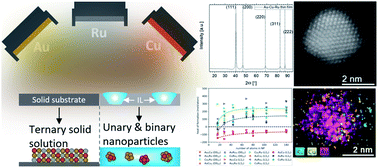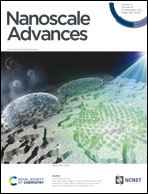Elemental (im-)miscibility determines phase formation of multinary nanoparticles co-sputtered in ionic liquids
Abstract
Non-equilibrium synthesis methods allow the alloying of bulk-immiscible elements into multinary nanoparticles, which broadens the design space for new materials. Whereas sputtering onto solid substrates can combine immiscible elements into thin film solid solutions, this is not clear for sputtering of nanoparticles in ionic liquids. Thus, the suitability of sputtering in ionic liquids for producing nanoparticles of immiscible elements is investigated by co-sputtering the systems Au–Cu (miscible), Au–Ru and Cu–Ru (both immiscible), and Au–Cu–Ru on the surface of the ionic liquid 1-butyl-3-methylimidazolium bis(trifluoromethylsulfonyl)imide [Bmim][(Tf)2N]. The sputtered nanoparticles were analyzed to obtain (i) knowledge concerning the general formation process of nanoparticles when sputtering onto ionic liquid surfaces and (ii) information, if alloy nanoparticles of immiscible elements can be synthesized as well as (iii) evidence if the Hume-Rothery rules for solid solubility are valid for sputtered nanoparticles. Nanoparticle characteristics were found to depend on elemental miscibility: (1) nanoparticles from immiscible elemental combinations showed bigger mean diameters ranging from (3.3 ± 1.4) nm to (5.0 ± 1.7) nm in contrast to mean diameters of nanoparticles from elemental combinations with at least one miscible element pair ((1.7 ± 0.7) nm to (1.8 ± 0.6) nm). (2) Nanoparticles from immiscible combinations showed compositions with one element strongly dominating the ratio and very narrow differences between the highest and lowest fraction of the dominating element (Cu94Ru6 to Cu100Ru0; Au96Ru4 to Au99Ru1) in contrast to the other compositions (Au64Cu36 to Au81Cu19; Au83Cu13Ru4/Au75Cu22Ru3 to Au87Cu11Ru2). Accompanying atomistic simulations using density-functional theory for clusters of different size and ordering confirm that the miscibility of Au–Cu and the immiscibility of Au–Ru and Cu–Ru govern the thermodynamic stability of the nanoparticles. Based on the matching experimental and theoretical results for the NP/IL-systems concerning NP stability, a formation model of multinary NPs in ILs was developed.

- This article is part of the themed collection: Celebrating nanoscience in Germany


 Please wait while we load your content...
Please wait while we load your content...